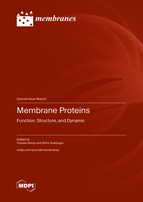Membrane Proteins: Function, Structure, and Dynamic
A special issue of Membranes (ISSN 2077-0375). This special issue belongs to the section "Biological Membrane Composition and Structures".
Deadline for manuscript submissions: closed (20 June 2023) | Viewed by 22772
Special Issue Editors
Interests: protein-lipid interaction; biomimetics; drug delivery system (DDS); biophysics; thermodynamics; synthetic biology; self-assembly; rheology; phase separation; biomembranes; lipid; liposome; cytoskeleton/cell motility; actin; structural biology; drug discovery
Special Issues, Collections and Topics in MDPI journals
2. Data Science Center, Nara Institute of Science and Technology, Nara 630-0192, Japan
3. Center for Digital Green-Innovation, Nara Institute of Science and Technology, Nara 630-0192, Japan
Interests: mechanisms of cell shaping and cell fate determination
Special Issues, Collections and Topics in MDPI journals
Special Issue Information
Dear Colleagues,
We are pleased to invite you to the Special Issue “Membrane Proteins: Function, Structure, and Dynamics.” Many proteins are known to interact with cell and subcellular membranes. These include transmembrane proteins (e.g., ion channels, transmembrane receptors, and transporters), which integrate into the lipid bilayers to transport molecules and ions across membranes, and peripheral membrane proteins, which temporarily associate with the membranes via electrostatic and/or hydrophobic interactions by dividing their amphipathic helix into lipid bilayers. These protein–lipid interactions determine protein conformations and precisely regulate the activation and localization of molecular complexes at their respective membranes. These signaling pathways play vital roles in various cellular processes, such as membrane trafficking and signal transduction. Furthermore, membrane proteins are involved in many diseases, including cancer and Alzheimer’s; thus, their possible applications in drug design should be considered. However, due to the complexity of the abundant lipid–protein/protein–protein interactions at the cell membranes, an exact understanding of the molecular and cellular mechanisms of membrane proteins has yet to be achieved.
This Special Issue aims to present recent advances in the function, structure, and dynamics of membrane proteins from various perspectives. These studies will shed light on the structural and physiological functions of membrane proteins and provide new insights into their fundamental workings.
Both original research articles and reviews are welcome. Areas of interest may include (but are not limited to) the following: cell biology, biochemistry, and biophysics, including structural biology and molecular dynamics (MD) simulations. Multidisciplinary approaches will also be considered. We look forward to receiving your contributions.
Dr. Yosuke Senju
Prof. Dr. Shiro Suetsugu
Guest Editors
Manuscript Submission Information
Manuscripts should be submitted online at www.mdpi.com by registering and logging in to this website. Once you are registered, click here to go to the submission form. Manuscripts can be submitted until the deadline. All submissions that pass pre-check are peer-reviewed. Accepted papers will be published continuously in the journal (as soon as accepted) and will be listed together on the special issue website. Research articles, review articles as well as short communications are invited. For planned papers, a title and short abstract (about 100 words) can be sent to the Editorial Office for announcement on this website.
Submitted manuscripts should not have been published previously, nor be under consideration for publication elsewhere (except conference proceedings papers). All manuscripts are thoroughly refereed through a single-blind peer-review process. A guide for authors and other relevant information for submission of manuscripts is available on the Instructions for Authors page. Membranes is an international peer-reviewed open access monthly journal published by MDPI.
Please visit the Instructions for Authors page before submitting a manuscript. The Article Processing Charge (APC) for publication in this open access journal is 2700 CHF (Swiss Francs). Submitted papers should be well formatted and use good English. Authors may use MDPI's English editing service prior to publication or during author revisions.
Keywords
- receptors
- channels
- transporters
- lipid–protein interactions
- signal transduction
- membrane traffic
- organelle
- membrane contact sites
- allosteric regulation
- model membranes and liposomes








